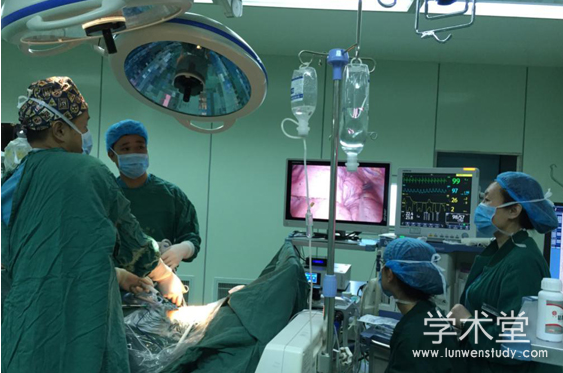摘 要
目的:
1. 探讨全麻及椎管内麻醉恢复期患者发生低体温的危险因素,并对危险因素的重要性进行排序,为针对性地采取措施预防麻醉恢复期患者低体温的发生提供理论依据。
2. 提出预防麻醉后低体温发生的策略,对充气加温毯的使用方法进行改良,并观察将其应用于麻醉恢复期低体温患者复温的效果,为临床寻找安全有效且经济方便的复温措施提供理论依据。
方法:
第一部分:选取山西省某三甲医院 2017 年 10 月至 2018 年 9 月术后进入麻醉恢复室的全麻及椎管内麻醉患者 3415 例,根据入麻醉恢复室时是否发生低体温分为低体温组和非低体温组,计算低体温的发生率并收集相关临床资料。在查阅文献的基础上,对可能与低体温相关的因素进行收集整理,进行单因素统计分析,将差异有统计学意义的因素进行多因素 Logistic 回归分析,筛查麻醉恢复期患者低体温的独立危险因素。采用机器学习模型对低体温的相关因素进行重要性排序。
第二部分:选取山西省某三甲医院麻醉恢复室低体温患者 80 例作为研究对象,将其随机分为两组,每组 40 例。在麻醉恢复室分别采取改良的充气保温被和充气加温毯为患者复温,比较两组患者的复温时间、复温速度、PACU 停留时间、寒战发生情况。采用独立样本 t 检验和卡方检验对数据进行统计分析。
结果:
第一部分:
1. 本研究共纳入患者 3415 例,其中 248 例患者发生麻醉恢复期低体温(低体温组),发生率为 7.26%;3167 例未发生低体温(体温正常组)。
2. 根据查阅文献结果,收集 16 个可能与患者低体温有关的因素进行单因素分析;结果显示两组间差异有统计学意义(P<0.05)的因素有:ASA 分级、专业、麻醉时间、年龄、输血、手术类型、手术时间、输液量、体质指数、体位、室温、常/急诊。而在患者性别、麻醉方式、循环系统合并症、术中血管活性药物使用上两组间差异无统计学意义(P>0.05)。
3. 多因素 Logistic 回归分析显示,泌尿外科专业手术、年龄>65 岁、手术时间>2h、输液量>1000mL、BMI<18.5、低室温是麻醉恢复期患者低体温的独立危险因素。
4. 经 XGBoost 和 Random Forest 机器学习模型计算,影响麻醉恢复期患者低体温的相关因素的重要性排序由高到低分别是患者的体质指数、手术时间、年龄、麻醉时间、输液量、血管活性药物使用情况、循环系统合并症、室温、手术专业、手术体位、手术类型、ASA 分级、麻醉方式、性别、输血量、常/急诊。
第二部分:
1. 80 例患者全部完成资料收集,每组 40 例。两组患者一般资料、入手术室耳温、术中手术室温度、手术时间、麻醉时间、术中输液量比较差异均无统计学意义(P>0.05)。
2. 两组患者入麻醉恢复室时均处于轻度低体温状态,入 PACU 耳温组间比较差异无统计学意义(P>0.05)。两组患者复温时间、复温速度、PACU 停留时间及寒战发生情况,组间比较差异均无统计学意义(P>0.05)。
结论:
1. 麻醉恢复期低体温是手术麻醉患者发生率较高的一个并发症(7.26%)。
2. 麻醉恢复期患者低体温的独立危险因素重要性排序由高到低分别是:体质指数 BMI<18.5、手术时间>2h、年龄>65 岁、输液量>1000mL、低室温、泌尿外科专业手术。
3. 对于轻度低体温患者,改良的充气保温被可以达到充气加温毯的复温效果,同时降低了成本,适用于麻醉恢复期低体温患者的复温。
关键词:麻醉恢复期;低体温;发生率;危险因素;复温。
Abstract
Objective:
1. The purpose of the study is to explore the risk factors of hypothermia in the recovery period of general anesthesia and spinal anesthesia, and rank the importance of risk factors so as to provide a theoretical basis for the prevention of hypothermia in anesthetic recovery room patients.
2. The strategy of preventing hypothermia after anesthesia was put forward. The use method of inflatable heated blanket was improved and the effect of applying it to rewarming patients with hypothermia in anesthetic recovery room was observed in order to provide a theoretical basis for finding safe, effective, economical and convenient rewarming measures in clinic.
Methods:
1.Part one: 3415 cases of general anesthesia and intraspinal anesthesia were selected from October 2017 to September 2018 in a third-class A hospital of Shanxi Province.According to whether hypothermia occurred in anesthetic recovery room, it was divided into hypothermia group and non-hypothermia group. The incidence of hypothermia was calculated and the related clinical data were collected. On the basis of literature review,the possible factors related to hypothermia were collected and sorted out for single factor statistical analysis. Multivariate Logistic regression analysis was conducted on the factors with statistical significance to screen the independent risk factors of hypothermia in patients in the anesthesia recovery room. Machine learning models were used to rank the importance of factors related to hypothermia.
2.Part two: 80 cases of hypothermia in anaesthesia recovery room of a third-class A hospital in Shanxi province were selected and randomly divided into two groups with 40 cases in each group. The patients were rewarmed by modified inflatable heating blanket and inflatable heating blanket in anesthetic recovery room. The rewarming time,rewarming speed, PACU stay time and shivering occurred were compared between thetwo groups. Independent sample t-test and chi-square test were used to analyze the data.
Results:
Part one:
1. A total of 3415 patients were included in this study, 248 patients among them had hypothermia during anesthesia recovery (hypothermia group), with an incidence of 7.26%; No hypothermia occurred in 3167 cases (normal body temperature group).
2. According to the results of literature review, 16 factors that may be related to hypothermia were collected for univariate analysis.The results showed that there were statistically significant differences between the two groups (P<0.05) : ASA classification,specialty, anesthesia time, age, blood transfusion, type of operation, operation time,volume of infusion, body mass index, body position, room temperature,frequent/emergency.There was no significant difference between the two groups in gender, anesthesia, circulatory complications and intraoperative use of vasoactive drugs (P>0.05).
3. Multivariate Logistic regression analysis showed that professional urologicalsurgery, age >65 years old, operation time >2h, infusion volume >1000mL, BMI<18.5,and low room temperature were independent risk factors for hypothermia of patients in the anesthesia recovery room.
4. Calculated by XGBoost and Random Forest machine learning model, the related factors affecting hypothermia in anesthetic recovery room importance ranking from high to low, respectively is body mass index (BMI), operation time, age, anesthesia time,volume of infusion, use of vasoactive drugs, circulatory complications, room temperature,major in surgery, posture, type of operation, ASA classification,anaesthesia, sex, blood transfusion, constant / emergency.
Part two:
1. All 80 patients completed data collection, 40 patients in each group.There were no statistically significant differences between the two groups in general information, ear temperature in operating room, operating room temperature, operation time, anesthesia time, and intraoperative infusion volume (P>0.05).
2. The patients in both groups were mild hypothermia when they entered the anesthetic recovery room, and there was no significant difference between the two groups (P>0.05). There was no significant difference in the time of rewarming, the speed of rewarming, the stay time of PACU and the occurrence of shivering between the two groups (P>0.05).
Conclusion:
1. Hypothermia in the anesthesia recovery room is a complication with a high incidence rate (7.26%).
2. The importance of independent risk factors for hypothermia in anesthesia recovery room was ranked from high to low: BMI<18.5, operative time >2h, age >65,infusion volume >1000mL, low room temperature, and professional urological surgery.
3. For patients with mild hypothermia, the modified inflatable heating quilt can achieve the rewarming effect of inflatable heating blanket, and at the same time reduce the cost, which is suitable for the rewarming of patients with hypothermia in the anesthesia recovery room.
Key words : postanesthesia care unit; hypothermia; incidence; risk factors; rewarming。
前 言
正常的体温是保证机体新陈代谢和正常生命活动的必要条件[1]。正常情况下,人体通过自主性和行为性体温调节机制来维持机体产热与散热的平衡,使体温恒定保持在 36.5~37.5℃[2]。而手术过程中,由于麻醉、手术、外周环境以及患者自身因素等的影响,容易造成患者体温下降。人体核心体温在 36℃以下称为体温过低[3]。大量研究显示,围术期低体温发生率较高(50%~70%)[4],而低体温会给患者带来多种并发症,如寒战、心血管功能异常、凝血功能障碍、苏醒延迟、切口感染等,影响患者的康复[5-10],延长住院时间,增加患者经济负担。因此,围术期低体温长久以来一直是国内外学者关注和研究的重要问题。
麻醉恢复室(postanesthesia care unit,PACU)是接受麻醉的患者术后苏醒恢复的场所,在这里由专业人员继续对患者持续监测生命体征,密切观察,继续治疗直到患者苏醒送返病房[11]。作为患者术后恢复的第一站,麻醉恢复室入室低体温率(PACU入室低体温患者/同期入 PACU 患者总数×100%)的监测具有重要的意义。美国麻醉医师协会(American Society of Anesthesiologists,ASA)将患者术后的体温作为评估医生是否遵循预防术中低体温指南的依据。美国围麻醉护士协会(American Society ofPerianesthesia Nurses,ASPAN)在 2009 年对预防患者低体温的临床实践指南进行了修订,正式将体温监测和保护列为麻醉恢复期护理的基本评价指标之一[12]。而我国也在2015 年采用 PACU 入室低体温率来反映患者围手术期的体温保护情况,并将其纳入麻醉专业医疗质量控制指标[13]。
经查阅文献,20 世纪 80 年代有报道,麻醉恢复室低体温发生率高达 60%[14]。近年来,随着加速康复外科的发展和优质护理的进一步推进,人们对患者围术期体温保护越来越重视,低体温的发生率发生了一定的变化,2016 年徐彦[15]等的研究报道,恢复室内低体温的总体发生率为 22.0%,较之前有明显下降,但全国情况仍需进行大样本的调查。
围术期患者低体温率的下降,得益于技术的进步和人们保温意识的增强。在美国等发达国家,围术期体温保护已经成为了常规做法。一些机构要求麻醉时间在 30 分钟以上的患者就必须进行体温监测,使用保温措施,使患者体温无论在术中还是在恢复期都维持在 36℃以上[16]。体温保护措施的选择,主要以主动保温和多种保温措施共同使用的复合保温为主,在众多体温保护措施中,充气加温毯是目前公认最安全有效且应用广泛的体温保护措施[17-19]。通过对患者术前、术中以及术后麻醉恢复室的全程保温,患者的远期预后如凝血功能、伤口感染等有了明显的改善。然而,尽管在发达国家已经形成了较为成熟的体温保护体系,但在大多数发展中国家,还未做到常规体温监测,体温保护措施多限于被动保温。卫生资源的数量有限和分布不均,可能是造成这一现象的重要原因。因此,评估患者发生低体温的风险,高效利用有限的卫生资源是现阶段解决问题的重要途径。
本研究拟对临床上大样本的数据进行整理分析,计算目前麻醉恢复期患者低体温的发生率,通过建立回归模型,分析导致患者低体温的危险因素,并对其重要性排序,从而帮助我们更好地识别患者发生低体温的风险,根据风险大小针对性地应用保温设备,尽可能减少患者低体温的发生。同时,努力探索一种安全有效、经济方便的复温措施,对已经发生低体温的患者在麻醉恢复室尽早复温,减少低体温造成的危害,促进患者快速康复。
第一部分 麻醉恢复期患者低体温发生率及危险因素分析。
人体核心体温低于 36℃为体温过低[3]。手术过程中,由于多种因素干扰患者体温调控系统,造成患者容易发生低体温,从而引起寒战、凝血功能异常、心血管不良事件风险增加等一系列并发症,影响患者术后康复。研究显示,围术期低体温发生率较高[4],但近年来,随着医疗的进步,患者低体温率发生了变化。本研究此部分旨在探讨目前麻醉恢复期患者低体温的发生率,分析导致其发生的危险因素,并根据其对体温影响的重要程度进行排序,为临床高效识别患者低体温风险,采取有效预防措施提供理论依据。
1 研究对象与方法。
1.1 研究对象。
选取 2017 年 10 月至 2018 年 9 月山西省某三甲医院麻醉科术后进入麻醉恢复室的患者 3436 例。
纳入标准:行非心脏手术的全身麻醉及椎管内麻醉患者。
排除标准:术前已存在发热或低体温的患者;术中需进行低体温保护重要脏器者;明确诊断为汗腺功能障碍者;有外耳道活动性疾病不能测量耳温者;患者重要信息记录不全者。最终,纳入符合入选标准的患者 3415 例。
1.2 样本量估算。
关于研究样本量的计算,根据统计学相关要求,样本量至少为变量数量的 10~15 倍,通过前期查阅文献,预计收集 16 个与患者低体温有关的因素。故计算得出样本量在 160~240 例之间,为了尽可能详细准确地分析麻醉恢复期患者低体温的危险因素,并充分考虑到实际病例数、大数据建模以及研究的人力、物力、可行性,选择将样本含量定为 3000 例。最终本研究纳入研究对象 3415 例。
【由于本篇文章为硕士论文,如需全文请点击底部下载全文链接】
1.3 研究方法
1.4 质量控制
1.5 机器学习模型
1.6 统计学处理
2 结 果
2.1 病例统计
2.2 单因素分析
2.3 多因素 Logistic 回归分析
2.4 进一步探究泌尿外科不同手术类型与患者体温的关系
2.5 相关因素重要性排序
3 讨 论
3.1 麻醉恢复期低体温发生率
3.2 麻醉恢复期低体温危险因素分析
3.3 麻醉恢复期低体温相关因素重要性排序
3.4 本研究的局限性
4 结 论
4.1 麻醉恢复期低体温发生率
4.2 麻醉恢复期低体温的独立危险因素重要性排序
第二部分 改良充气保温被对麻醉恢复期低体温患者复温的效果观察
1 研究对象与方法
1.1 研究对象
1.2 研究方法
1.3 观察指标
1.4 质量控制
1.5 统计学方法
2 结 果
2.1 两组患者一般情况比较
2.2 两组患者手术麻醉情况比较
2.3 两组患者麻醉恢复期复温情况比较
3 讨 论
3.1 复温护理在麻醉恢复期患者护理中的重要性
3.2 促进麻醉恢复期低体温患者体温恢复的有效措施
3.3 两种复温措施的成本分析
3.4 局限性与不足
4 结 论
对于轻度低体温患者,改良的充气保温被可以达到充气加温毯的复温效果,同时降低了成本,适用于麻醉恢复期低体温患者复温。
参考文献
